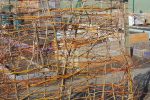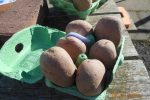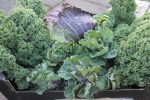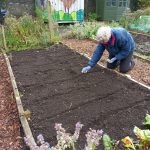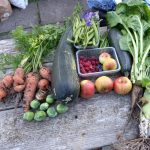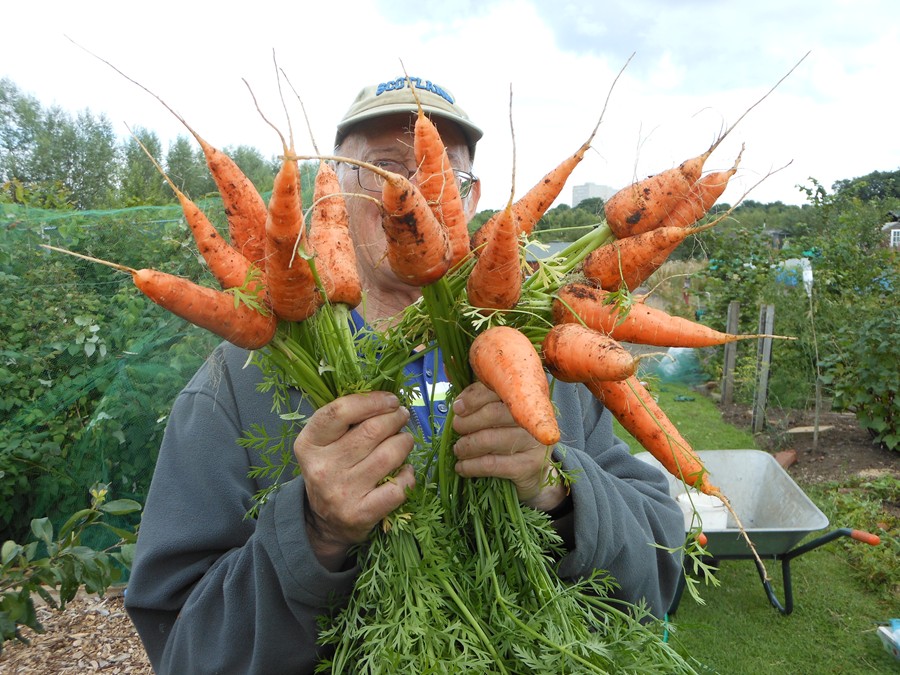
Caley Allotment
Caley Allotment Video
Take a little stroll around The Caley Demonstration Allotment in Edinburgh
Click on the picture to view the video.
History
It was thanks to George Anderson, the then President of the Caley, that we obtained a large allotment plot at the new Bridgend Organic Allotment site in 2005. George was keen to enhance the educational role of the Caley.
Fortunately the site was clean land, having previously been farmland, so that there was no reservoir of pests and diseases. It had been roughly cleared and marked out, but it proved to be extremely stony, sometimes requiring pickaxes to dig it. The site slopes gently to the north and is very exposed so needed wind breaks to be put in place. Willows were planted at west end, and hazels at the east both of both of which are coppiced.
As time went on.
The initial layout was eight wide beds with grass paths. Within a couple of years the beds had been made narrower and were raised, with the wooden edges helping to reduce soil compaction. The smaller beds also helped to reduce workload. The grass paths were removed and replaced with woodchip paths. Borders of flowering plants, wildflowers and comfrey were planted to help enhance biodiversity.
A four bed rotation scheme for vegetable growing was established with the aim to grow a large range of vegetables. We sowed seeds for popular and heritage varieties and also tried out some new varieties. The goal was to be able to harvest a green vegetable fifty two weeks of the year.
Fruit trees were sourced and planted. A wide variety of soft fruit was planted, most of which was donated by Dr Rex Brennan of the James Hutton Institute at Invergowrie, Dundee.
The Rhythm of the Seasons
Spring – is always busy with soil preparation, seed sowing and planting
Summer – watering when needed and harvesting
Autumn and Winter – harvesting, coppicing willow and hazel, general repairs, bonfires to clear debris. We use the wood ash as it is an excellent source of potash.
And always weeding!
Each year we run a different trial, for example varieties of green manure, biochar as soil improver, several varieties of peas and beans, quinoa. The results are varied but inform our practice now.
Allotment Maintenance
To deal with the exposed site we have tried various forms of windbreak. Currently the decorative windbreak uses stems from the hazel and willow coppicing. A dead hedge was tried, but abandoned after two years because it became a refuge for vermin and harboured hogweed.
Soil fertility is improved by digging in compost made on site, and farmyard manure. Comfrey is regularly cut, then either composted or made into a liquid feed. Plants are fed with either liquid seaweed feed, blood, fish and bone or organic chicken pellets.
As with all allotments, pests and diseases need to be addressed. Strong healthy plants resist, but can be helped by fine mesh netting and other barriers.
Workshops and Open Days
There are regular allotment Open Days and twice yearly we hold well-attended pruning workshops which are led by George Anderson. The Summer Workshop coincides with the Open Day when there is produce, jam and refreshments on offer.
We continue to interact with the allotment community through our hut’s notice board, providing information on current work. We attend allotment events and have given talks, for example, on pest control.
Showing and Exhibiting
In 2007 and 2013 we entered the Pallet Gardens competition at Gardening Scotland. Both entries receiving gold awards. Our 2013 entry had a Japanese theme. This was the year that we started our bed of Japanese vegetables and it continues to interest visitors.
We regularly have entries in the Dalkeith Horticultural Society Flower Show and, of course, have entries in The Caley’s Spring Bulb Show.
Find out more
Caley volunteers normally work on the allotment on Thursdays. They are a hardy bunch and can be found working whatever the weather. They are usually onsite from 10am onwards. Caley members and visitors are welcome to pop along to see what is going on, but please do check with them before you go. Contact Moira on: rchsallotment@gmail.com. The Caley allotment is part of the Brigend Allotment site at 41 Old Dalkeith Road, Edinburgh, EH16 4TE
New volunteers are very welcome to join the team. Email: administrator@rchs.co.uk if you are interested in finding out more. You must be a Caley member to volunteer at the allotment.
We have a regular Allotment Blog. You can follow us by subscribing on the blog page of the website.
Photo Album

Click on the image to view the album
Information Sheets
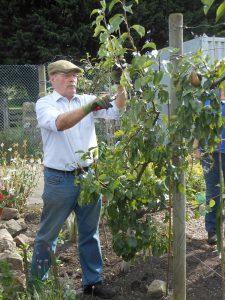
Want to find out how to prune your fruit trees? Not sure what to do with your raspberries and strawberries? Click below to download a fact sheet with lots of helpful tips from George Anderson of the Beechgrove Garden (he also just happens to be Honorary President of The Caley).
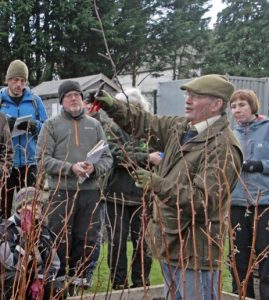
Give your fruit trees and bushes some attention in Autumn/ Winter to ensure a bumper crop of fruit the following summer. Click below to download our fact sheet with all you need to know about winter fruit pruning.
Catch up with all the news from the allotment!

